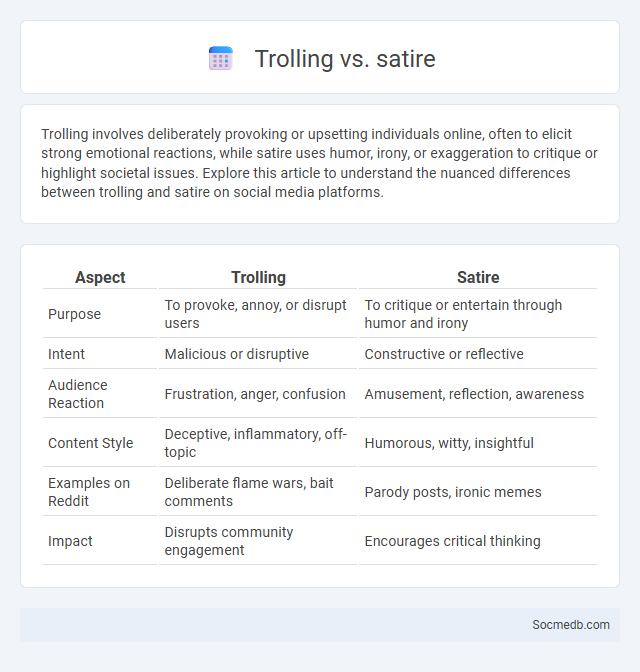
Photo illustration: trolling vs satire
Trolling involves deliberately provoking or upsetting individuals online, often to elicit strong emotional reactions, while satire uses humor, irony, or exaggeration to critique or highlight societal issues. Explore this article to understand the nuanced differences between trolling and satire on social media platforms.
Table of Comparison
| Aspect | Trolling | Satire |
|---|---|---|
| Purpose | To provoke, annoy, or disrupt users | To critique or entertain through humor and irony |
| Intent | Malicious or disruptive | Constructive or reflective |
| Audience Reaction | Frustration, anger, confusion | Amusement, reflection, awareness |
| Content Style | Deceptive, inflammatory, off-topic | Humorous, witty, insightful |
| Examples on Reddit | Deliberate flame wars, bait comments | Parody posts, ironic memes |
| Impact | Disrupts community engagement | Encourages critical thinking |
Understanding Trolling: Definition and Characteristics
Trolling on social media involves deliberately posting provocative, inflammatory, or off-topic messages to disrupt conversations and elicit emotional responses. Common characteristics include anonymity, persistence, and the use of sarcastic or hostile language designed to provoke anger or confusion. Understanding trolling is essential for managing online communities and maintaining healthy digital interactions.
Satire Explained: Purpose and Techniques
Satire on social media serves to critique societal norms and behaviors through humor, irony, and exaggeration, often highlighting absurdities to provoke thought and spark dialogue. Techniques like parody, sarcasm, and hyperbole are commonly used to engage audiences while masking critical commentary in entertainment. This approach leverages viral trends and relatable content to spread awareness and challenge prevailing ideologies effectively.
Rule Violations: What Counts as Crossing the Line
Rule violations on social media include hate speech, harassment, and spreading misinformation that harms individuals or communities. Your content crosses the line if it promotes violence, violates privacy, or infringes on intellectual property rights. Platforms enforce strict policies to maintain a safe environment and may suspend accounts that breach these guidelines repeatedly.
Key Differences Between Trolling and Satire
Trolling involves deliberately provoking or upsetting others online through inflammatory, offensive comments aimed at generating a negative reaction, whereas satire uses humor, irony, or exaggeration to critique social or political issues constructively. Your ability to distinguish between harmful trolling and insightful satire is essential for maintaining respectful and meaningful interactions on social media platforms. Recognizing these key differences enhances your digital literacy and helps create a more positive online environment.
Intent vs. Impact: Decoding Online Behavior
Social media interactions often reveal a disparity between user intent and the impact of their messages, as posts intended to inform or entertain can inadvertently offend or mislead diverse audiences. Algorithms prioritize emotionally charged content, amplifying misunderstandings and escalating conflicts among users. Understanding this dynamic is crucial for developing strategies that promote clearer communication and reduce negative online behavior consequences.
How Satire Can Be Mistaken for Trolling
Satire on social media often blends humor with criticism, which can easily be misconstrued as trolling due to its sarcastic and exaggerated tone. You may find that satirical posts provoke strong reactions because the intent is to highlight societal flaws or absurdities, not to incite conflict. Understanding the subtle cues behind satire helps distinguish it from harmful trolling behaviors online.
The Role of Community Guidelines in Moderating Content
Community guidelines serve as essential frameworks that shape user behavior and set clear standards for acceptable content on social media platforms. These policies help platforms efficiently identify and remove harmful, misleading, or inappropriate material, ensuring a safer online environment. Effective moderation grounded in well-defined community guidelines fosters user trust and promotes healthy, constructive interactions within digital communities.
Case Studies: Real Examples of Trolling, Satire, and Rule Violation
Case studies of social media reveal diverse instances of trolling, satire, and rule violations that highlight platform vulnerabilities and user behavior patterns. High-profile examples like the 2016 US election interference illustrate coordinated trolling campaigns that exploit algorithmic biases, while satirical accounts such as The Onion demonstrate the fine line between humor and misinformation. Rule violations are prominently seen in bans of accounts spreading hate speech or fake news, emphasizing the challenges platforms face in content moderation and policy enforcement.
Navigating Free Speech and Responsible Communication
Social media platforms serve as powerful tools for free speech, enabling users to share ideas and opinions globally. You must balance this freedom with responsible communication by adhering to community guidelines and respecting diverse perspectives. Maintaining this equilibrium fosters a respectful online environment while protecting your right to express yourself.
Promoting a Healthy Online Environment
Creating a healthy online environment requires consistent efforts to promote respectful communication, prevent cyberbullying, and encourage positive interactions across social media platforms. You can contribute by setting boundaries, reporting harmful content, and supporting mental well-being through balanced screen time and mindful engagement. Social media companies are increasingly implementing algorithms and community guidelines to foster safe and inclusive digital spaces for all users.
 socmedb.com
socmedb.com